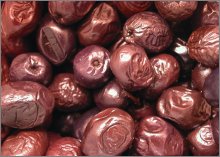Olives: How Healthy are They? Which Olives are Best?
by www.SixWise.com
Olives are one of the oldest foods known to man, dating back
some 8,000 years in the Mediterranean region. The olive tree
was valued as a symbol of peace and happiness, while olives
were used as food and a source of oil.
|

Olive soup is a good remedy for a sore throat, according
to traditional Chinese medicine (it's also the only
time olives are used in Chinese cuisine).
|
Today everyone knows how good olive
oil is for health, but the humble olive is often passed
up (often because they've unfairly gotten a bad rap for being
high in fat). However, olives are actually a very healthy
fruit, one that's been lending superb nutrition to mankind
for centuries. So there's no need to pass up that tempting
olive bar at the market any longer -- olives are good for
you!
All Olives Start Out Green
If you take a look at your local supermarket, you'll see
olives in a rainbow of colors, from green to brown to purple
to black, with flavors just as diverse, ranging from sweet
to sour. But all olives actually start out the same: green.
Unripe olives are incredibly bitter and not edible. To become
the tasty fruits you're more familiar with, they must have
their bitterness, which is caused by a substance called oleuropin,
removed. This is done through a variety of curing processes,
as even simply cooking an olive is not enough to get rid of
the bitterness.
|

Some Olive Varieties You
May Not Have Heard Of …
-
Beldi: A small, fruity olive from Morocco.
-
Halkidiki: A tangy green olive from Greece's Halkidiki
peninsula.
-
Gaeta: A small, salty Italian olive.
-
Cerignola: A very meaty, giant green olive harvested
in Cerignola, Italy.
-
Bitetto: A sweeter olive from southern Italy.
|
Olives are picked at varying stages of ripeness (as they
ripen they gradually turn from green to black) and cured using
one of several processes, including soaking in oil, brine
or water, or dry packing in salt. A more artificial (but faster,
taking only days as opposed to months) method also used (particularly
for canned black olives) is soaking the olives in lye, which
removes the bitterness but also takes away much of the olive's
flavor.
The Health Benefits of Olives
Traditionally cured olives, such as those found at most olive
bars, offer a host of health benefits. For starters, they're
rich in iron, vitamin E and copper, and are an excellent source
of fiber. But what about all the fat?
It's true that olives do have some fat, but it's the incredibly
healthy monounsaturated variety. Monounsaturated fats have
been found to reduce the risk of atherosclerosis and increase
HDL (good) cholesterol.
However, olives contain a triple whammy for your health that
works in synergy to provide extreme benefits. Along with monounsaturated
fats, olives are rich in vitamin E, a fat-soluble antioxidant
that neutralizes damaging free radicals, along with polyphenols
and flavonoids, which have anti-inflammatory properties.
It is the combination of these three health-boosting compounds
that make olives:
-
Have a protective effect on cells that can lower the
risk of damage and inflammation
-
Help reduce the severity of asthma, osteoarthritis, and
rheumatoid arthritis
-
Help prevent heart disease
-
Help prevent colon cancer
-
Help prevent the frequency and intensity of hot flashes
in women going though menopause
When choosing olives for their health benefits (and flavor)
always opt for those that have been traditionally cured (as
opposed to lye-processed). No matter what the variety, they're
sure to add a burst of flavor and nutrition to any dish.
Love Olives? Try These Delicious
(and Unique) Recipes!
Green Olive Soup
Ingredients:
- 2 cups cracked green olives, Mideastern or Greek, soaked
in water for an hour, drained, and chopped
- 2 Tablespoons olive oil
- 1 onion, chopped
- 2 cloves garlic, chopped
- 3 Tablespoons olive oil
- 4 Tablespoons flour
- 1/8 teaspoon cayenne
- 8 cups vegetable or chicken stock
- 1/2 cup heavy cream
- 1/4 cup dry sherry
Garnish: minced parsley
Method:
- In a large saucepan, sauté the onions, garlic,
and two-thirds of the olives in the olive oil until the
onions are transparent. Puree with 1 cup of stock.
- Heat oil in the saucepan and stir in flour and cayenne,
cooking into a roux. Whisk in remaining stock, then pour
in the puree. Bring to a slow boil, let thicken, then reduce
heat and simmer for 20 minutes. Stir in cream, pepper, and
remaining chopped olives, bring back to a boil, then simmer
5 more minutes.
- When ready to serve, heat to serving temperature, stir
in sherry and cook for a minute, then ladle into bowls.
Garnish with generous pinches of minced parsley.
Source: SoupSong.com
Homemade Olive Tapenade
Ingredients:
- 20 pitted Kalamata olives, coarsely chopped
- 1 tablespoon rinsed, drained, and chopped capers
- 1 teaspoon fresh lemon juice
- 2 teaspoons olive oil
- 1/2 teaspoon anchovy paste (optional)
- Fresh cracked black pepper
Method:
- Mix well. Refrigerate and use within two weeks.
- Use as a spread for sandwiches like panini and muffaletta,
serve with crackers or use as a condiment.
Source: CDKitchen.com
Recommended Reading
The
6 Healthiest Staple Foods in Greek Cuisine
Jicama:
the Healthy, Versatile Vegetable that Tastes Like a Fruit
and Acts Like a Water Chestnut
Sources
The
World's Healthiest Foods
Whole
Foods Market